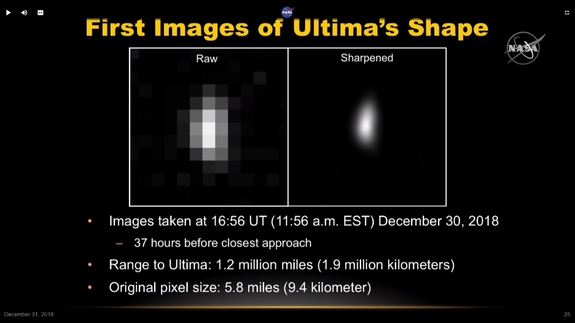NASA’s New Horizons spacecraft was rocketing toward history Monday as it neared the most distant world ever visited by a human-made object: the mysterious, icy Ultima Thule, 1 billion miles beyond Pluto and an astounding 4 billion miles from Earth.
New Horizons is on track to reach its closest point to Ultima Thule — 2,200 miles — in a flyby at a speed of about 31,500 mph at 12:33 a.m. EST on New Year’s Day.
Ultima Thule (officially 2014 MU69) is believed to be a pristine remnant of the birth of the solar system. It could unlock clues to galactic secrets and the process that formed our universe. Ultima Thule orbits the sun from the Kuiper Belt — a massive region of frozen rocky bodies beyond Neptune’s orbit. Its name means “distant places beyond the known world.”
Ultima Thule, first spotted by NASA’s Hubble Telescope in 2014, is likely a dark, complex shape, and it could be two bodies. It takes Ultima Thule 298 years to orbit the sun. Clear images so far are only artists’ renderings. Scientists are hopeful New Horizons will capture the real thing.
“We’re going to learn more very soon,” John Spencer, New Horizons deputy project scientist, said Monday. “We just can’t wait.”
The New Horizons mission is operated by the Johns Hopkins Applied Physics Laboratory in Maryland. The flyby will be covered on the lab’s website, its YouTube channel and NASA TV. Updates will also be posted on Twitter at @NewHorizons2015 and @NASANewHorizons.
The craft will collect images and scientific data — including geological and atmospheric information — to beam back to Earth.
New Horizons launched in 2006 and rocketed past Pluto in 2015.

NASA
Bagikan Berita Ini














0 Response to "NASA Tracking Flyby Of Most Distant Space Expedition In Human History - HuffPost"
Post a Comment